Microperforated Compostable Packaging Extends Shelf Life of Ethylene-Treated Banana Fruit
Abstract
:1. Introduction
2. Materials and Methods
2.1. Plant Materials
2.2. Packaging Materials
2.3. Storage Regimes
2.4. Quality Evaluation
2.5. Statistical Analysis
3. Results
4. Discussion
5. Conclusions
- Microperforated biodegradable packaging allowed the buildup of beneficial MA, preventing hypoxic fermentation and improving fruit preservation.
- The biodegradable packages had somewhat higher water vapor permeability, as compared to conventional plastics, and caused no water condensation.
- The fruit weight loss in biodegradable packaging was higher than in conventional plastic bags, but still 3–4-fold lower than in open containers.
- The control of senescence spotting was the major advantage of microperforated biodegradable packaging, combined with the preservation of acceptable fruit firmness and flavor, and low crown rot incidence.
- The shelf life of bananas in optimal biodegradable packages was extended by four days compared with open containers, and by two days compared with the best commercial plastic package tested.
- Optimally perforated compostable packages combine the advantage of sustainability with beneficial modified humidity and modified atmosphere generation. Keeping ethylene-treated bananas in such packages reduces food losses, with minimal pressure on the environment.
Author Contributions
Funding
Institutional Review Board Statement
Informed Consent Statement
Data Availability Statement
Acknowledgments
Conflicts of Interest
References
- Hailu, M.; Workneh, T.S.; Belew, D. Review on postharvest technology of banana fruit. Afr. J. Biotech. 2013, 12, 635–647. [Google Scholar] [CrossRef]
- Voora, V.; Larrea, C.; Bermudez, S. Global Market Report: Bananas. IISD. 2020. Available online: https://www.iisd.org/system/files/publications/ssi-global-market-report-banana.pdf (accessed on 3 December 2021).
- Payasi, A.; Sanwal, G. Ripening of climacteric fruits and their control. J. Food Biochem. 2010, 34, 679–710. [Google Scholar] [CrossRef]
- Thompson, A.K.; Supapvanich, S.; Sirison, J. Banana Ripening: Science and Technology; Springer Nature: Cham, Switzerland, 2019. [Google Scholar] [CrossRef]
- Krishnakumar, T.; Thirupathi, V. Shelf life extension of ethylene treated bananas at different storage temperature with the ethylene action inhibitor, 1-methylcyclopropene. Trends Biosci. 2014, 22, 3673–3679. [Google Scholar]
- Ketsa, S. Development and control of senescent spotting in banana. Food Preserv. Sci. 2000, 26, 173–178. [Google Scholar] [CrossRef] [Green Version]
- Finlay, A.R.; Brown, A.E. The relative importance ofColletotrichum musaeas a crown-rot pathogen on Windward Island bananas. Plant Pathol. 1993, 42, 67–74. [Google Scholar] [CrossRef]
- Duan, X.; Joyce, D.C.; Jiang, Y.M. Postharvest biology and handling of banana fruit. Fr. Prod. 2007, 1, 140–152. [Google Scholar]
- Marrero, A.; Gonzalez, M.; Baez, O.; Lobo, M. Control of artificial ripening of bananas through atmosphere modification and refrigeration. In Proceedings of the International Controlled Atmosphere Research Conference, Leuven, Belgium, 10 March 2003; Volume 600, pp. 393–399. [Google Scholar]
- Klieber, A.; Bagnato, N.; Barrett, R.; Sedgley, M. Effect of post-ripening nitrogen atmosphere storage on banana shelf life, visual appearance and aroma. Postharvest Biol. Technol. 2002, 25, 15–24. [Google Scholar] [CrossRef]
- Pesis, E.; Ben Arie, R.; Feygenberg, O.; Villamizar, F. Ripening of ethylene-pretreated bananas is retarded using modified atmosphere and vacuum packaging. HortScience 2005, 40, 726–731. [Google Scholar] [CrossRef] [Green Version]
- Adams, A.; Salifu, A.W.; Inusah, L.; Peter, P. Modified insulated punnets and conventional packaging films for retail storage of robusta banana fruits. J. Sci. Agric. 2017, 1, 46–53. [Google Scholar] [CrossRef]
- Mangaraj, S.; Goswami, T.K.; Mahajan, P.V. Applications of plastic films for modified atmosphere packaging of fruits and vegetables: A review. Food Eng. Rev. 2009, 1, 133–158. [Google Scholar] [CrossRef]
- Kader, A.A. A summary of CA requirements and recommendations for fruits other than apples and pears. In Proceedings of the International Controlled Atmosphere Research Conference, Leuven, Belgium, 10 March 2003; Volume 600, pp. 737–740. [Google Scholar]
- Choehom, R.; Ketsa, S.; van Doorn, W.G. Senescent spotting of banana peel is inhibited by modified atmosphere packaging. Postharvest Biol. Technol. 2004, 31, 167–175. [Google Scholar] [CrossRef]
- Wade, N.L. Effects of oxygen concentration and ethephon upon the respiration and ripening of banana fruits. J. Exp. Bot. 1974, 25, 955–964. [Google Scholar] [CrossRef]
- Nkwachukwu, O.I.; Chima, C.H.; Ikenna, A.O.; Albert, L. Focus on potential environmental issues on plastic world towards a sustainable plastic recycling in developing countries. Int. J. Ind. Chem. 2013, 4, 34. [Google Scholar] [CrossRef] [Green Version]
- Wróblewska-Krepsztul, J.; Rydzkowski, T.; Borowski, G.; Szczypiński, M.; Klepka, T.; Thakur, V.K. Recent progress in biodegradable polymers and nanocomposite-based packaging materials for sustainable environment. Int. J. Polym. Anal. Charact. 2018, 23, 383–395. [Google Scholar] [CrossRef]
- Mooney, B.P. The second green revolution? Production of plant-based biodegradable plastics. Biochem. J. 2009, 418, 219–232. [Google Scholar] [CrossRef] [Green Version]
- Dilkes-Hoffman, L.S.; Lane, J.L.; Grant, T.; Pratt, S.; Lant, P.; Laycock, B. Environmental impact of biodegradable food packaging when considering food waste. J. Clean. Prod. 2018, 180, 325–334. [Google Scholar] [CrossRef]
- Abdul-Rahaman, A.; Bishop, C. Evaluating the effects of biodegradable and conventional modified atmosphere packaging on the shelf life of organic Cavendish bananas. J. Postharvest Technol. 2013, 1, 29–35. [Google Scholar]
- Nissenbaum, D.; Neuman, T.; Pelled, D.; Garty, S.; Konieczny, N. Biodegradable Sheet. U.S. Patent 11,007,758 B2, 27 April 2020. issued 18 May 2021. [Google Scholar]
- Hu, Y.; Topolkaraev, V.; Hiltner, A.; Baer, E. Measurement of water vapor transmission rate in highly permeable films. J. Appl. Polym. Sci. 2001, 81, 1624–1633. [Google Scholar] [CrossRef]
- McHugh, T.H.; Avena-Bustillos, R.; Krochta, J. Hydrophilic edible films: Modified procedure for water vapor permeability and explanation of thickness effects. J. Food Sci. 1993, 58, 899–903. [Google Scholar] [CrossRef]
- Fishman, S.; Rodov, V.; Ben-Yehoshua, S. Mathematical model for perforation effect on oxygen and water vapor dynamics in modified-atmosphere packages. J. Food Sci. 1996, 61, 956–961. [Google Scholar] [CrossRef]
- Cussler, E.L. Diffusion: Mass Transfer in Fluid Systems, 2nd ed.; Cambridge University Press: Cambridge, UK; New York, NY, USA, 1997; 580p, ISBN 978-0-521-56477-9. [Google Scholar]
- Rodov, V.; Ben-Yehoshua, S.; Aharoni, N.; Cohen, S. Modified humidity packaging of fresh produce. In Horticultural Reviews, Volume 37; Janick, J., Ed.; Wiley-Blackwell: Hoboken, NJ, USA, 2010; pp. 281–330. [Google Scholar]
- Owoyemi, A.; Porat, R.; Rodov, V. Effects of compostable packaging and perforation rates on cucumber quality during extended shelf life and simulated farm-to-fork supply-chain conditions. Foods 2021, 10, 471. [Google Scholar] [CrossRef] [PubMed]
- Owoyemi, A.; Rodov, V.; Porat, R. Retaining red bell pepper quality by perforated compostable packaging. Food Sci. Nutr. 2021, 9, 3683–3692. [Google Scholar] [CrossRef] [PubMed]
- Mistriotis, A.; Briassoulis, D.; Giannoulis, A.; D’Aquino, S. Design of biodegradable bio-based equilibrium modified atmosphere packaging (EMAP) for fresh fruits and vegetables by using micro-perforated poly-lactic acid (PLA) films. Postharvest Biol. Technol. 2016, 111, 380–389. [Google Scholar] [CrossRef]
- Aharoni, N.; Rodov, V.; Fallik, E.; Afek, U.; Chalupowicz, D.; Aharon, Z.; Maurer, D.; Orenstein, J. Modified atmosphere packaging for vegetable crops using high-water-vapor-permeable films. In Intelligent and Active Packaging for Fruits and Vegetables; Wilson, C.L., Ed.; CRC Press: Boca Raton, FL, USA, 2007; pp. 73–112. [Google Scholar]
- Harnkarnsujarit, N.; Li, Y. Structure-property modification of microcrystalline cellulose film using agar and propylene glycol alginate. J. Appl. Polym. Sci. 2017, 134, 45533. [Google Scholar] [CrossRef]
- Wang, J.; Gardner, D.J.; Stark, N.M.; Bousfield, D.W.; Tajvidi, M.; Cai, Z. Moisture and oxygen barrier properties of cellulose nanomaterial-based films. ACS Sustain. Chem. Eng. 2018, 6, 49–70. [Google Scholar] [CrossRef]
- Guillard, V.; Gaucel, S.; Fornaciari, C.; Angellier-Coussy, H.; Buche, P.; Gontard, N. The next generation of sustainable food packaging to preserve our environment in a circular economy context. Front. Nutr. 2018, 5, 121. [Google Scholar] [CrossRef] [Green Version]
- Kimbuathong, N.; Leelaphiwat, P.; Harnkarnsujarit, N. Inhibition of melanosis and microbial growth in Pacific white shrimp (Litopenaeus vannamei) using high CO2 modified atmosphere packaging. Food Chem. 2019, 312, 126114. [Google Scholar] [CrossRef]
- Shinde, R.; Rodov, V.; Krishnakumar, S.; Subramanian, J. Active and intelligent packaging for reducing postharvest losses of fruits and vegetables. In Postharvest Biology and Nanotechnology; Paliyath, G., Ed.; John Wiley & Sons: Hoboken, NJ, USA, 2019; pp. 171–189. [Google Scholar]

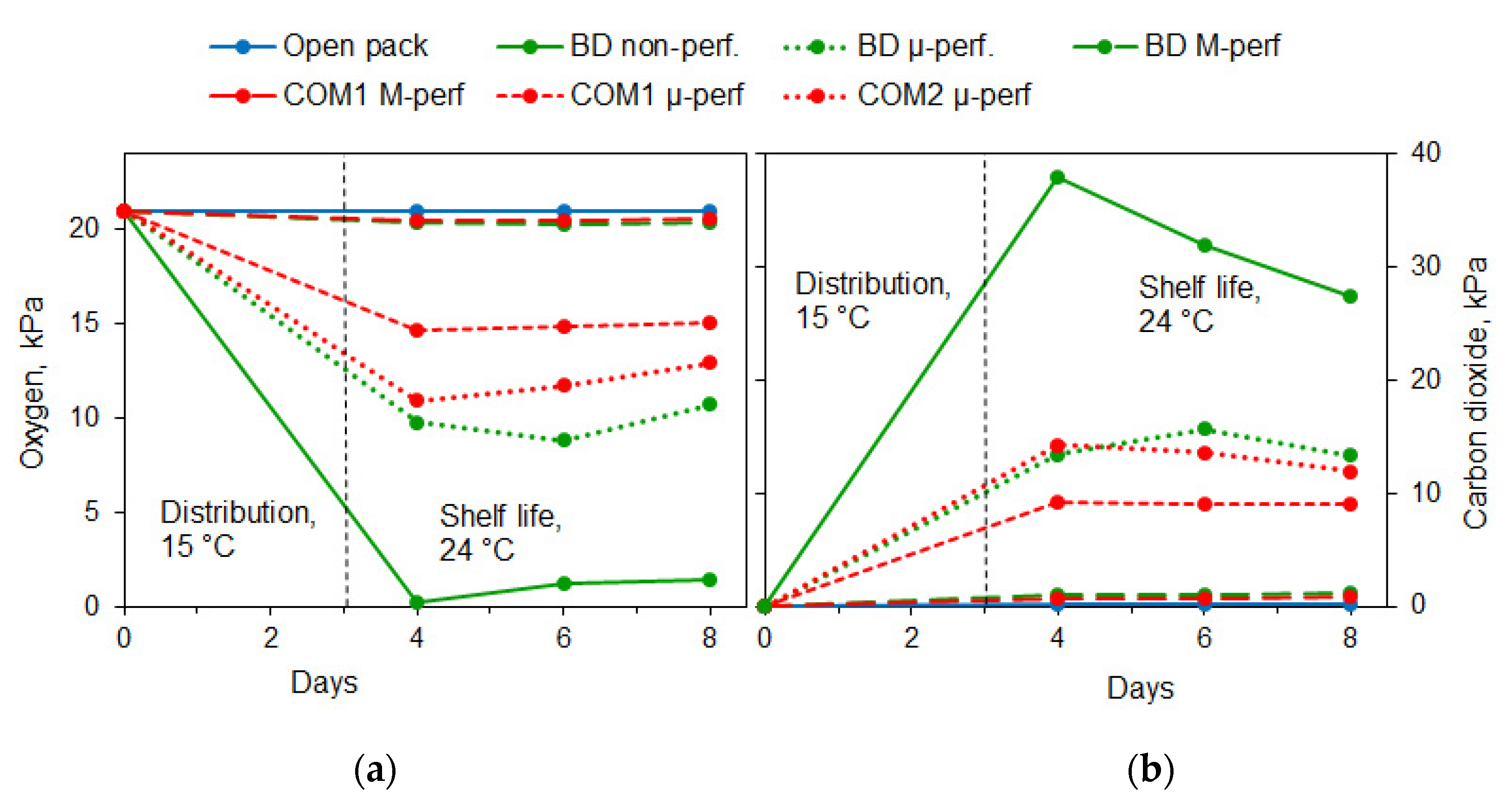
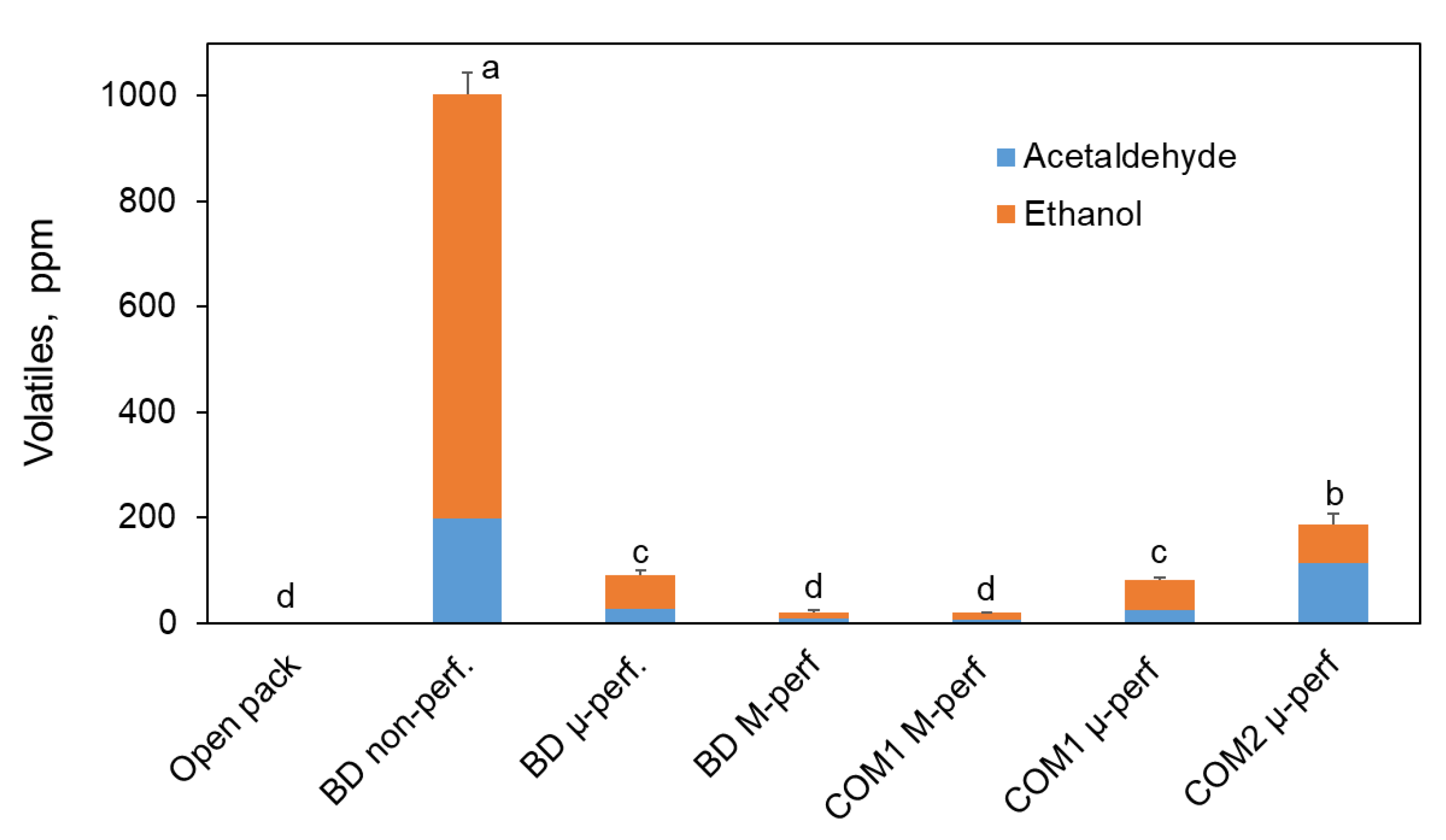
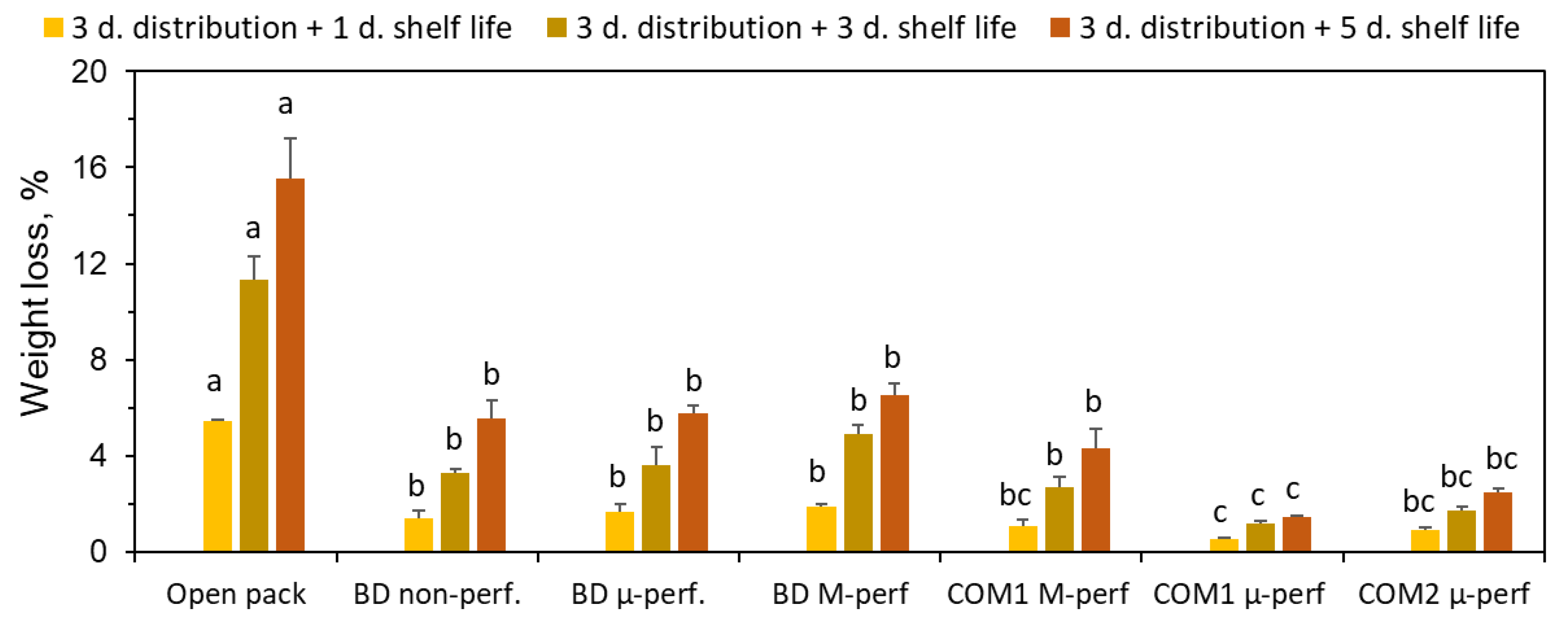

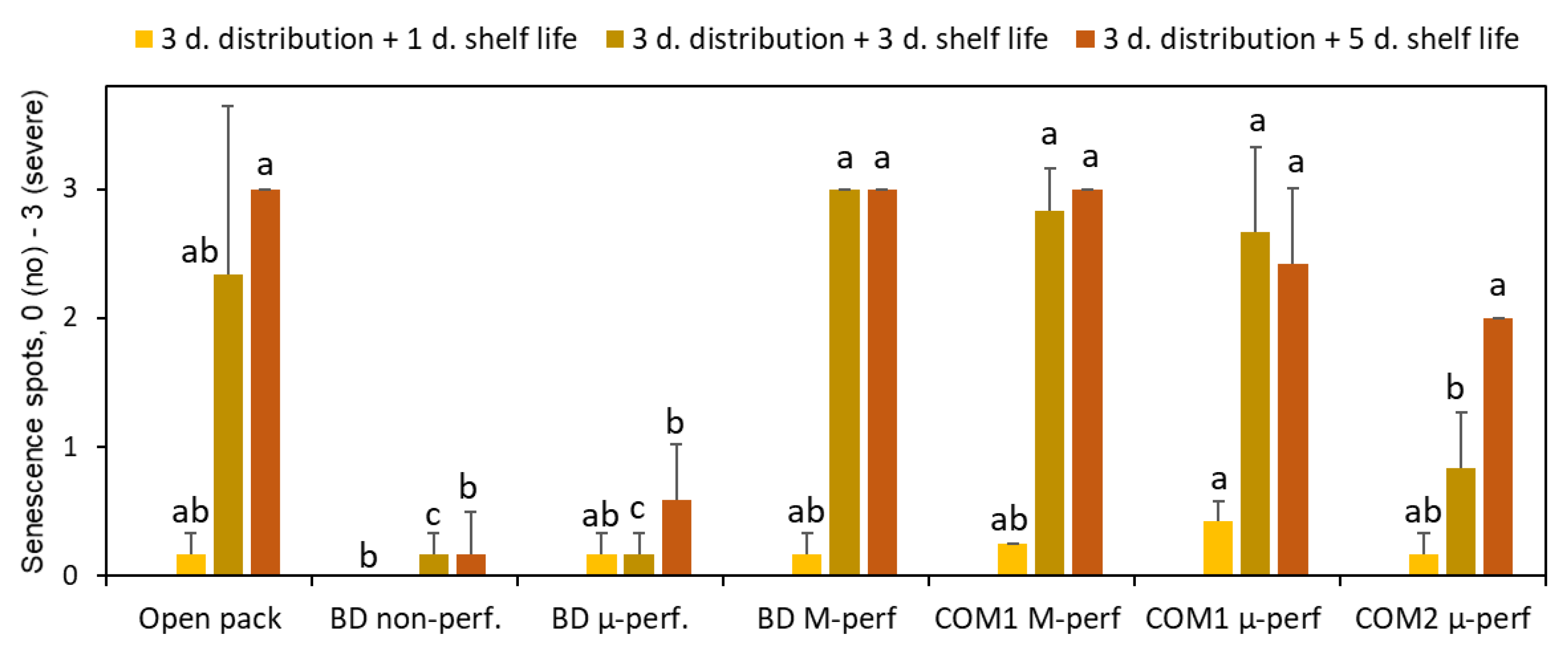

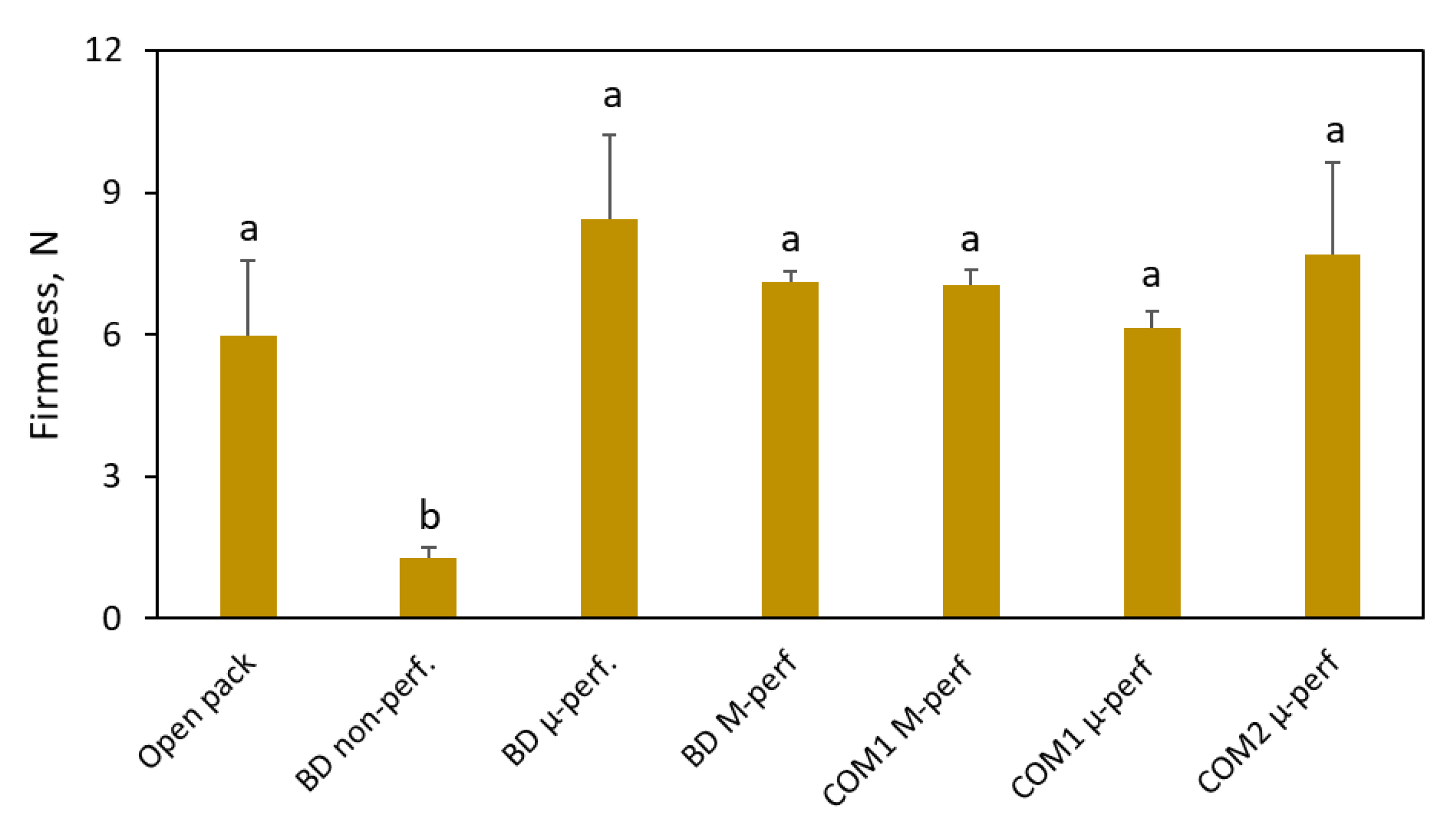

Publisher’s Note: MDPI stays neutral with regard to jurisdictional claims in published maps and institutional affiliations. |
© 2022 by the authors. Licensee MDPI, Basel, Switzerland. This article is an open access article distributed under the terms and conditions of the Creative Commons Attribution (CC BY) license (https://creativecommons.org/licenses/by/4.0/).
Share and Cite
Rodov, V.; Porat, R.; Sabag, A.; Kochanek, B.; Friedman, H. Microperforated Compostable Packaging Extends Shelf Life of Ethylene-Treated Banana Fruit. Foods 2022, 11, 1086. https://doi.org/10.3390/foods11081086
Rodov V, Porat R, Sabag A, Kochanek B, Friedman H. Microperforated Compostable Packaging Extends Shelf Life of Ethylene-Treated Banana Fruit. Foods. 2022; 11(8):1086. https://doi.org/10.3390/foods11081086
Chicago/Turabian StyleRodov, Victor, Ron Porat, Amit Sabag, Bettina Kochanek, and Haya Friedman. 2022. "Microperforated Compostable Packaging Extends Shelf Life of Ethylene-Treated Banana Fruit" Foods 11, no. 8: 1086. https://doi.org/10.3390/foods11081086
APA StyleRodov, V., Porat, R., Sabag, A., Kochanek, B., & Friedman, H. (2022). Microperforated Compostable Packaging Extends Shelf Life of Ethylene-Treated Banana Fruit. Foods, 11(8), 1086. https://doi.org/10.3390/foods11081086







